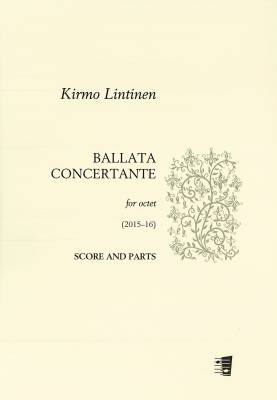Ballata Concertante (2015-16) : score and parts — For "Schubert"-octet (cl, fg, hrn, vl 1, vl 2, vla, vcl, cb)
Lintinen, KirmoProduct information
| Title: | Ballata Concertante (2015-16) : score and parts — For "Schubert"-octet (cl, fg, hrn, vl 1, vl 2, vla, vcl, cb) | ||
| Authors: | Lintinen, Kirmo (Composer) | ||
| Product number: | 9790550114401 | ||
| Product form: | Sheet music | ||
| Availability: | Delivery in 7-16 days | ||
| Price per piece: | 53,58 € (47,00 € vat 0 %) | ||
|
|||
| Publisher: | Fennica Gehrman |
| Edition: | 2018 |
| Publication year: | 2018 |
| Language: | many languages, Finnish , English |
| Pages: | 136 |
| Product family: | Other ensembles Chamber music |
| Finnish library classification: | 78.517 Oktetit |
| Key words: | oktetti, Renesanssimusiikki, Kirmo Lintinen |
In Ballata Concertante (2015-2016) Lintinen looks back in time, to the Italy of the "trecento" and specifically the Renaissance Florence. The music of the trecento may provide the starting point for stylistic allusions but it is anything but a one-to-one correspondence. It may speak the language of the 14th century, but it does so with a modernist accent, rather as the Neoclassicists last century spoke the language of the 18th century. The archaic-sounding opening section harks back to the music of the trecento, but the cello melody a little later already comes closer to the present day. Lintinen compares the impression to that of a tourist travelling to Florence today and becoming immersed in Renaissance art. Lintinen’s ensemble is the same as that of Schubert’s Octet. He did not, however, aim at Schubert’s orchestral sound. The music of the first half is coloured by the alternation of strings and winds. Lintinen says, “The presence of three wind players inspired the idea of a three-voice group of soloists for which I could write as for three singers.” Ballata concertante is a rhythmically vibrant piece, and since it is intended for performance without a conductor, the episodes are naturally linked together by means of such devices as rhythmic modulations.” Score and parts are sold together.
--
Yleisradion tilaama Ballata concertante (2015-16) avaa Lintisen musiikin tyylillistä asteikkoa 1300-luvun eli "trecenton" Italiaan ja nimenomaisesti Firenzeen, jossa alkoi tuolloin nousta renessanssin kulttuurisen murroksen varhaisimpia ituja. Ballata concertantessa trecenton musiikki muodostaa lähtökohdan tyylillisille viittauksille, mutta mistään yksi-yhteen-suhteesta ei ole kyse; jos teos puhuu 1300-luvun kieltä, se puhuu sitä modernisti murtaen, hiukan samaan tapaan kuin viime vuosisadan uusklassikot puhuivat 1700-luvun kieltä. Arkaaisesti soivassa alkujaksossa syntyy viittaus trecenton musiikkiin, mutta sellon hiukan myöhempi melodialinja on jo luonteeltaan nykyaikaisempi. Lintinen vertaa vaikutelmaa siihen, että oman aikamme turisti matkaa Firenzeen ja eläytyy siellä renessanssin kauden taiteisiin.
Lintisen käyttämä kokoonpano on sama, jolle Schubert sävelsi oman oktettonsa. Sen orkestraaliseen sointiin Lintinen ei kuitenkaan ole pyrkinyt. Alkupuolella musiikkia värittää jousten ja puhaltajien vuorottelu. Lintinen kertoo, että "kolmen puhaltajan läsnäolo synnytti ajatuksen kolmiäänisestä solistiryhmästä, jolle voi kirjoittaa kolmiäänisen laulusatsin tapaan". Teos rakentuu rytmisesti eläväksi kokonaisuudeksi, ja koska se on ajateltu esitettäväksi ilman johtajaa, sen jaksot niveltyvät luontevasti toisiinsa mm. rytmisten modulaatioiden avulla. Partituuri ja stemmat myydään yhdessä paketissa.
--
Yleisradion tilaama Ballata concertante (2015-16) avaa Lintisen musiikin tyylillistä asteikkoa 1300-luvun eli "trecenton" Italiaan ja nimenomaisesti Firenzeen, jossa alkoi tuolloin nousta renessanssin kulttuurisen murroksen varhaisimpia ituja. Ballata concertantessa trecenton musiikki muodostaa lähtökohdan tyylillisille viittauksille, mutta mistään yksi-yhteen-suhteesta ei ole kyse; jos teos puhuu 1300-luvun kieltä, se puhuu sitä modernisti murtaen, hiukan samaan tapaan kuin viime vuosisadan uusklassikot puhuivat 1700-luvun kieltä. Arkaaisesti soivassa alkujaksossa syntyy viittaus trecenton musiikkiin, mutta sellon hiukan myöhempi melodialinja on jo luonteeltaan nykyaikaisempi. Lintinen vertaa vaikutelmaa siihen, että oman aikamme turisti matkaa Firenzeen ja eläytyy siellä renessanssin kauden taiteisiin.
Lintisen käyttämä kokoonpano on sama, jolle Schubert sävelsi oman oktettonsa. Sen orkestraaliseen sointiin Lintinen ei kuitenkaan ole pyrkinyt. Alkupuolella musiikkia värittää jousten ja puhaltajien vuorottelu. Lintinen kertoo, että "kolmen puhaltajan läsnäolo synnytti ajatuksen kolmiäänisestä solistiryhmästä, jolle voi kirjoittaa kolmiäänisen laulusatsin tapaan". Teos rakentuu rytmisesti eläväksi kokonaisuudeksi, ja koska se on ajateltu esitettäväksi ilman johtajaa, sen jaksot niveltyvät luontevasti toisiinsa mm. rytmisten modulaatioiden avulla. Partituuri ja stemmat myydään yhdessä paketissa.




